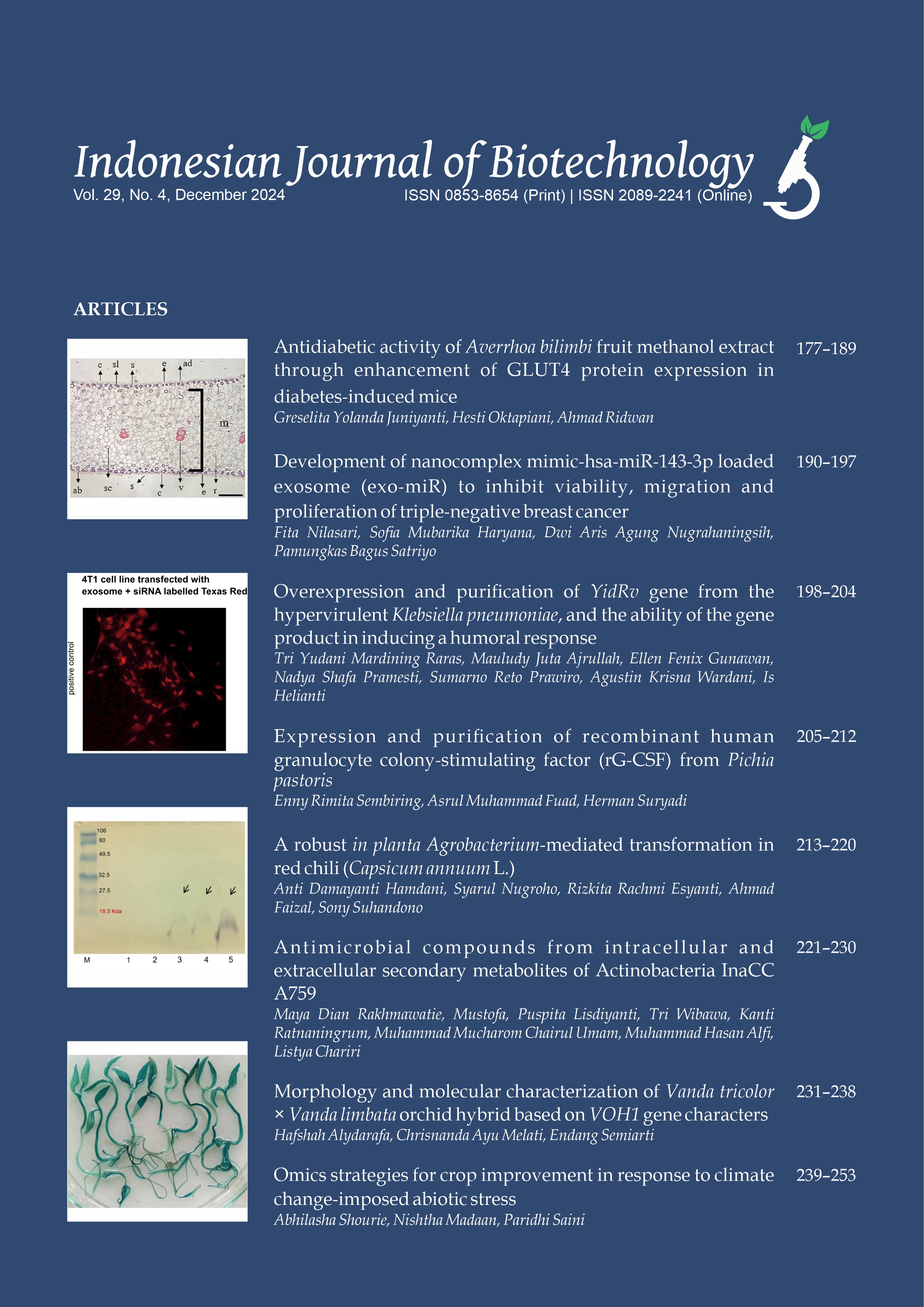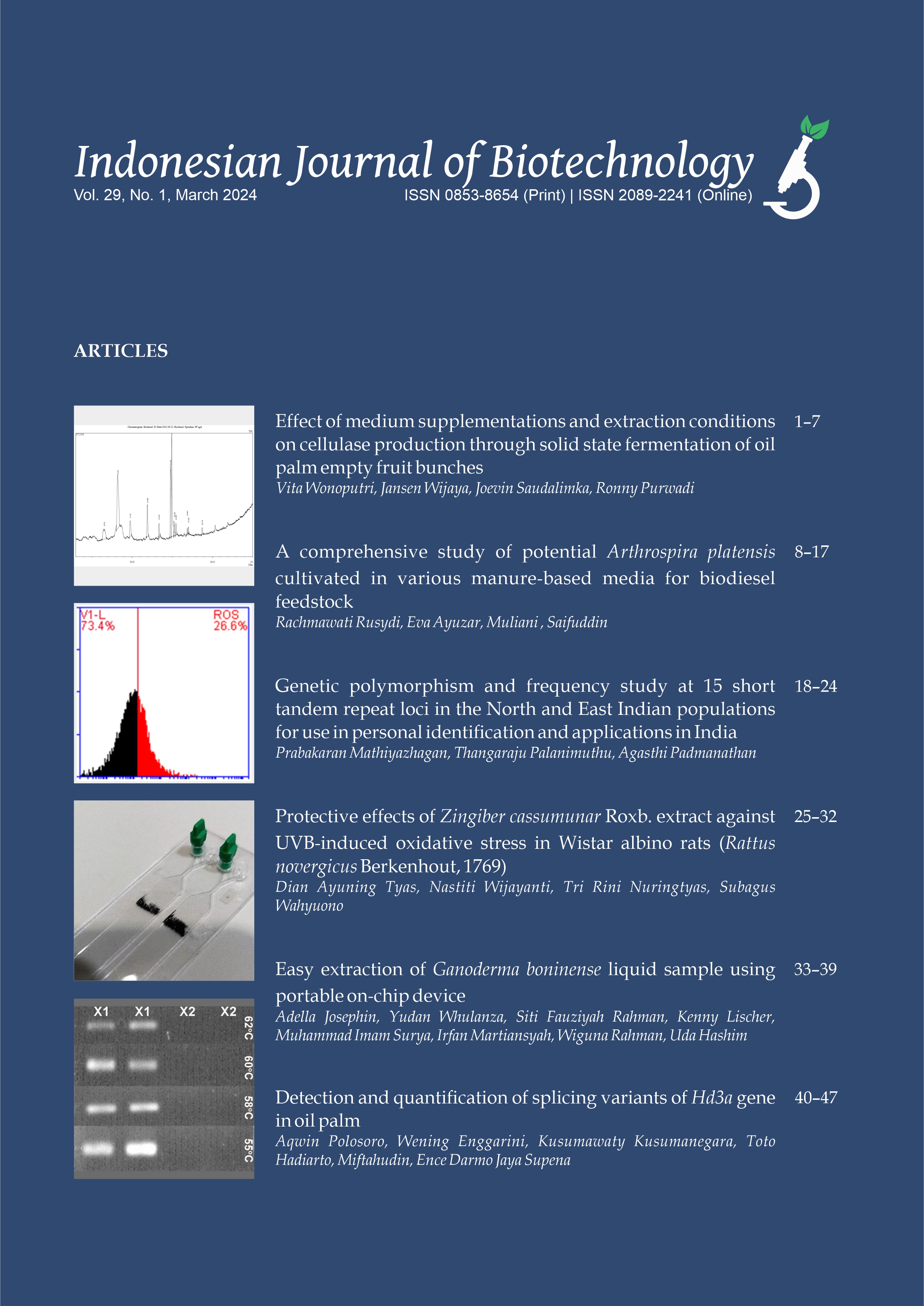Effect of galangal essential oils on rumen microbial population and biodiversity on in vitro rumen fermentation
Dewi Ratih Ayu Daning(1), Budi Prasetyo Widyobroto(2), Lies Mira Yusiati(3), Chusnul Hanim(4*)
(1) Universitas Gadjah Mada, Jl. Fauna No. 3, Karang Gayam, Caturtunggal, Sleman, D.I. Yogyakarta 55281, Indonesia; Politeknik Pembangunan Pertanian Malang, Jl.Dr. Cipto 144 a Bedali, Lawang 65200, East Java, Indonesia
(2) Universitas Gadjah Mada, Jl. Fauna No. 3, Karang Gayam, Caturtunggal, Sleman, D.I. Yogyakarta 55281, Indonesia
(3) Universitas Gadjah Mada, Jl. Fauna No. 3, Karang Gayam, Caturtunggal, Sleman, D.I. Yogyakarta 55281, Indonesia
(4) Universitas Gadjah Mada, Jl. Fauna No. 3, Karang Gayam, Caturtunggal, Sleman, D.I. Yogyakarta 55281, Indonesia
(*) Corresponding Author
Abstract
Keywords
Full Text:
PDFReferences
ÁlvarezMartínez FJ, BarrajónCatalán E, HerranzLópez M, Micol V. 2021. Antibacterial plant compounds, extracts and essential oils: An updated review on their effects and putative mechanisms of action. Phytomedicine 90:153626. doi:10.1016/j.phymed.2021.153626.
Apel MA, AF Rodrigues R, Lira Soares LA, Henriques AT. 2017. Quantification of the components in commercial essential oil of Eucalyptus globulus Labill. by Gas Chromatography – GCFID and GCMS. Drug Anal. Res. 1(2):9–14. doi:10.22456/2527 2616.79217.
Bokulich NA, Subramanian S, Faith JJ, Gevers D, Gordon JI, Knight R, Mills DA, Caporaso JG. 2013. Qualityfiltering vastly improves diversity estimates from Illumina amplicon sequencing. Nat. Methods 10(1):57– 59. doi:10.1038/nmeth.2276.
BouarabChibane L, Forquet V, Lantéri P, Clément Y, LéonardAkkari L, Oulahal N, Degraeve P, Bordes C. 2019. Antibacterial properties of polyphenols: Characterization and QSAR (Quantitative structureactivity relationship) models. Front. Microbiol. 10(APR):1–23. doi:10.3389/fmicb.2019.00829.
Carrasco JMD, Cabral C, Redondo LM, Pin Viso ND, Colombatto D, Farber MD, Fernández Miyakawa ME. 2017. Impact of chestnut and quebracho tannins on rumen microbiota of bovines. Biomed Res. Int. 2017:1–11. doi:10.1155/2017/9610810.
ChaucheyrasDurand F, Ossa F. 2014. The rumen microbiome: Composition, abundance, diversity, and new investigative tools. Prof. Anim. Sci. 30(1):1–12. doi:10.15232/S10807446(15)300760.
Chouchen R, Attia K, Darej C, Moujahed N. 2018. Potential of eucalyptus (Eucalyptus camaldulensis) essential oil to modify in vitro rumen fermentation in sheep. J. Appl. Anim. Res. 46(1):1220–1225. doi:10.1080/09712119.2018.1486318.
Chouhan S, Sharma K, Guleria S. 2017. Antimicrobial activity of some essential oils—Present status and future perspectives. Medicines 4(3):58. doi:10.3390/medicines4030058.
Colombini S, Rota Graziosi A, Parma P, Iriti M, Vitalini S, Sarnataro C, Spanghero M. 2021. Evaluation of dietary addition of 2 essential oils from Achillea moschata, or their components (bornyl acetate, camphor, and eucalyptol) on in vitro ruminal fermentation and microbial community composition. Anim. Nutr. 7(1):224–231. doi:10.1016/j.aninu.2020.11.001.
Daning DRA, Widyobroto BP, Hanim C, Muhlisin, Yusiati LM. 2022a. Effect of galangal essential oils on enzyme activity and nutrient digestibility in in vitro rumen fermentation. Livest. Res. Rural. Dev. 34(12):114. URL https://www.lrrd.org/lrrd34/12/341 14lies.html.
Daning DRA, Yusiati LM, Hanim C, Widyobroto BP. 2022b. Dietary supplementation of galangal (Alpinia galangal) essential oil affects rumen fermentation pattern. Adv. Anim. Vet. Sci. 10(2):323. doi:10.17582/JOURNAL.AAVS/2022/10.2.323.334.
Edgar RC. 2004. MUSCLE: Multiple sequence alignment with high accuracy and high throughput. Nucleic Acids Res. 32(5):1792–1797. doi:10.1093/nar/gkh340.
Edgar RC. 2013. UPARSE: Highly accurate OTU sequences from microbial amplicon reads. Nature Methods 10(10):996–998. doi:10.1038/nmeth.2604.
Edgar RC, Haas BJ, Clemente JC, Quince C, Knight R. 2011. UCHIME improves sensitivity and speed of chimera detection. Bioinformatics 27(16):2194– 2200. doi:10.1093/bioinformatics/btr381.
Faleiro ML. 2011. The mode of antibacterial action of essential oils. Sci. against Microb. Pathog. Commun. Curr. Res. Technol. Adv. 3(3):1143–1156.
Fitriastuti R, Yusiati LM, Widyobroto BP, Bachruddin Z, Hanim C. 2019. Effect of cashew nutshell oil supplementation as phenol source for protein protection on in vitro nutrient digestibility. Bul. Peternak. 43(4):225–230. doi:10.21059/buletinpeternak.v43i4.35591.
Haas BJ, Gevers D, Earl AM, Feldgarden M, Ward DV, Giannoukos G, Ciulla D, Tabbaa D, Highlander SK, Sodergren E, Methé B, DeSantis TZ, Petrosino JF, Knight R, Birren BW. 2011. Chimeric 16S rRNA sequence formation and detection in Sanger and 454pyrosequenced PCR amplicons. Genome Res. 21(3):494–504. doi:10.1101/gr.112730.110.
Hendry ER, Worthington T, Conway BR, Lambert PA. 2009. Antimicrobial efficacy of eucalyptus oil and 1,8cineole alone and in combination with chlorhexidine digluconate against microorganisms grown in planktonic and biofilm cultures. J. Antimicrob. Chemother. 64(6):1219–1225. doi:10.1093/jac/dkp362.
Iqbal MW, Zhang Q, Yang Y, Zou C, Li L, Liang X, Wei S, Lin B. 2018. Ruminal fermentation and microbial community differently influenced by four typical subtropical forages in vitro. Anim. Nutr. 4(1):100–108. doi:10.1016/j.aninu.2017.10.005.
Jami E, White BA, Mizrahi I. 2014. Potential role of the bovine rumen microbiome in modulating milk composition and feed efficiency. PLoS One 9(1):e85423. doi:10.1371/journal.pone.0085423.
Jarrell KF, Ding Y, Nair DB, Siu S. 2013. Surface appendages of archaea: Structure, function, genetics and assembly. doi:10.3390/life3010086.
Jewell KA, McCormick CA, Odt CL, Weimer PJ, Suen G. 2015. Ruminal bacterial community composition in dairy cows is dynamic over the course of two lactations and correlates with feed efficiency. Appl. Environ. Microbiol. 81(14):4697–4710. doi:10.1128/AEM.0072015.
Kataria RP. 2016. Use of feed additives for reducing greenhouse gas emissions from dairy farms. Microbiol. Res. (Pavia). 6(1):19–25. doi:10.4081/mr.2015.6120.
Kim H, Jung E, Lee HG, Kim B, Cho S, Lee S, Kwon I, Seo J. 2019. Essential oil mixture on rumen fermentation and microbial community An in vitro study. AsianAustralasian J. Anim. Sci. 32(6):808– 814. doi:10.5713/ajas.18.0652.
Kim JN, Méndez–García C, Geier RR, Iakiviak M, Chang J, Cann I, Mackie RI. 2017. Metabolic networks for nitrogen utilization in Prevotella ruminicola 23. Sci. Rep. 7(1):1–11. doi:10.1038/s41598017084633.
Lavrenčič A, Levart A. 2021. In vitro dry matter and crude protein rumen degradation and abomasal digestibility of soybean meal treated with chestnut and quebracho wood extracts. Food Sci. Nutr. 9(2):1034–1039. doi:10.1002/fsn3.2072.
Lely N, Nurhasana F, Azizah M. 2017. Aktivitas antibakteri minyak atsiri rimpang lengkuas merah (Alpinia purpurata K. Schum) terhadap bakteri penyebab diare. Sci. J. Farm. dan Kesehat. 7(1):42. doi:10.36434/scientia.v7i1.104.
Leondro H, Widyobroto BP, Adiarto A, Agus A. 2019. The effect of protected soybean meal as a protein supplement on blood metabolites of lactating dairy cows. J. IlmuIlmu Peternak. 29(2):178–184. doi:10.21776/ub.jiip.2019.029.02.09.
Magoč T, Salzberg SL. 2011. FLASH: Fast length adjustment of short reads to improve genome assemblies. Bioinformatics 27(21):2957–2963. doi:10.1093/bioinformatics/btr507.
Ministry of Trade of the Republic of Indonesia. 2011. Indonesian essential oils : The scents of natural life. Handb. Commod. Profile 1st:52. Morgavi DP, Kelly WJ, Janssen PH, Attwood GT. 2013. Rumen microbial (meta)genomics and its application to ruminant production. Animal 7(SUPPL.1):184– 201. doi:10.1017/S1751731112000419.
Nagaraja TG. 2016. 1st ed. Millen DD, De Beni Arrigoni M, Lauritano Pacheco RD, editors. Switzerland: Springer International Publishing. doi:10.1007/978 3319305332.
Oonmettaaree J, Suzuki T, Gasaluck P, Eumkeb G. 2006. Antimicrobial properties and action of galangal (Alpinia galanga Linn.) on Staphylococcus aureus. LWT 39(10):1214–1220. doi:10.1016/j.lwt.2005.06.015.
Patra A, Park T, Kim M, Yu Z. 2017. Rumen methanogens and mitigation of methane emission by antimethanogenic compounds and substances. J. Anim. Sci. Biotechnol. 8(1):1–18. doi:10.1186/s40104017 01459.
Patra AK. 2012. Dietary phytochemicals and microbes, volume 9789400739260. Springer. doi:10.1007/978 9400739260.
Pereira PS, Maia AJ, Duarte AE, OliveiraTintino CDM, Tintino SR, Barros LM, VegaGomez MC, Rolón M, Coronel C, Coutinho HD, da Silva TG. 2018. Cytotoxic and antikinetoplastid potential of the essential oil of Alpinia speciosa K. Schum. Food Chem. Toxicol. 119:387–391. doi:10.1016/j.fct.2018.01.024.
Qin L, Li WC, Liu L, Zhu JQ, Li X, Li BZ, Yuan YJ. 2016. Inhibition of ligninderived phenolic compounds to cellulase. Biotechnol. Biofuels 9(1):1–10. doi:10.1186/s1306801604852.
Rawel HM, Meidtner K, Kroll J. 2005. Binding of selected phenolic compounds to proteins. J. Agric. Food Chem. 53(10):4228–4235. doi:10.1021/jf0480290.
Sofyan A, Uyeno Y, Shinkai T, Hirako M, Kushibiki S, Kanamori H, Mori S, Katayose Y, Mitsumori M. 2019. Metagenomic profiles of the rumen microbiota during the transition period in lowyield and highyield dairy cows. Anim. Sci. J. 90(10):1362–1376. doi:10.1111/asj.13277.
Surendran A, Siddiqui Y, Ali NS, Manickam S. 2018. Inhibition and kinetic studies of cellulose and hemicellulosedegrading enzymes of Ganoderma boninense by naturally occurring phenolic compounds. J. Appl. Microbiol. 124(6):1544–1555. doi:10.1111/jam.13717.
Tang X, Xu C, Yagiz Y, Simonne A, Marshall MR. 2018. Phytochemical profiles, and antimicrobial and antioxidant activities of greater galangal [Alpinia galanga (Linn.) Swartz.] flowers. Food Chem. 255:300–308. doi:10.1016/j.foodchem.2018.02.027.
Wang L, Zhang K, Zhang C, Feng Y, Zhang X, Wang X, Wu G. 2019. Dynamics and stabilization of the rumen microbiome in yearling Tibetan sheep. Sci. Rep. 9(1):19620. doi:10.1038/s41598019562063.
Wang Q, Garrity GM, Tiedje JM, Cole JR. 2007. Naïve Bayesian classifier for rapid assignment of rRNA sequences into the new bacterial taxonomy. Applied and Environmental Microbiology 73(16):5261–5267. doi:10.1128/AEM.0006207.
Xue MY, Sun HZ, Wu XH, Liu JX, Guan LL. 2020. Multiomics reveals that the rumen microbiome and its metabolome together with the host metabolome contribute to individualized dairy cow performance. Microbiome 8(1):1–19. doi:10.1186/s40168020 008198.
Young G. 2019. Essential oils pocket references. China: Life Science Publishing. Zengin H, Baysal AH. 2014. Antibacterial and antioxidant activity of essential oil terpenes against pathogenic and spoilageforming bacteria and cell structureactivity relationships evaluated by SEM microscopy. Molecules 19(11):17773–98. doi:10.3390/molecules191117773.
Zhu Z, Difford GF, Noel SJ, Lassen J, Løvendahl P, Højberg O. 2021. Stability assessment of the rumen bacterial and archaeal communities in dairy cows within a single lactation and its association with host phenotype. Front. Microbiol. 12:1–15. doi:10.3389/fmicb.2021.636223.
Article Metrics
Refbacks
- There are currently no refbacks.
Copyright (c) 2022 The Author(s)

This work is licensed under a Creative Commons Attribution-ShareAlike 4.0 International License.









